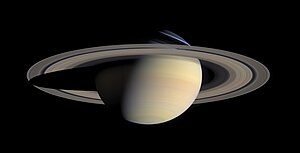
Natural color view of Saturn, composed from a series of pictures taken by the Cassini spacecraft. (Photo credit: Wikipedia)
At the beginning of July, I talked about the many sights to see in the morning sky. Now through the end of July, the most exciting time is in the evening at dusk.
Looking West-Southwest about an hour aftter sunset, you will see the Moon waxing night after night from a thin sliver to first quarter. Beginning tonight you will have to look closely near the horizon. Can you see a silver eyelash? By July 23 more of the crescent will grow and become not only brighter, but higher up. On July 25, half of the Moon is illuminated.
If you have a telescope or binoculars, look along the boundary of light and dark for lots of contrast. These are the best places to view craters, as they cast long shadows across the Moon’s surface.
While you’re out looking at the Moon, Mars and Saturn are also in the neighborhood. Mars is the red planet slightly higher than the Moon, while Saturn is the yellow planet, also above the Moon.
While you have your telescope out, focus on Saturn. Can you see its rings and four moons? Because of Saturn’s position relative to the Sun and us right now, it will appear especially three-dimensional through a telescope (or binocs). Saturn wil also be casting a shadow on its own rings.
So there you have it – several beautiful things to look for in the night sky.
Till next month, Always Look Up!
